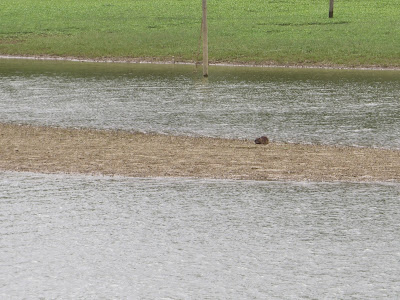The Portsmouth based band were later to become
GENTLE GIANT
also the title of their first extremely well structured album.

See the world in the palm of his hand,
Giant steps that will cover the land!
Our
final full day in Luc - Armau as the weather continues to hold and the
morning was spent idling in the garden looking for 'wild-things'. The
HUMMING-BIRD HAWK-MOTHS

are still in residence

and the GRAPES continue to swell.
I'm
sure at the claim of Kites the reader would not be surprised given our
location, the only question being Red or Black Kite? Both are common
here but thus far neither have been spotted, but late afternoon, after
our day out, there was to be a change to that but by no means what might
have been expected. The story continues later........

First outing of the day was to the nearby,
homely and most friendly
LE PETIT LARMANOU RESTAURANT

another firm favourite with Hugh and Janet.

We all started with the hearty Vegetable Soup,

then for me there was once again no resisting the local
CANARD, for starter the Foie Gras

followed by Confit of Duck,

while the ladies opted for OMELETTE

and Hugh the COQ au VIN.

Bon Apitit

The FIG FLAN was almost as good as Janet's (home made) before
left home but was lacking that golden yellow Custard.
A very pleasant midday meal with charming mine host and
a Air France Airline Pilot and his Lady who were fellow diners.

was the next port of call and a short walk

along the lakeside.
Not exactly brimming with birds, Mallard, Coot, Common Snipe,
Mute Swan, Great Crested Grebe, Little Egret, Chiffchaff along with
Great Spotted Woodpecker were all in attendance but there
was much besides.

BEAUTIFUL DEMOISELLE

were not only as the name suggests but also numerous

while there were also a few of these bright orange SLUGS,
but there was a surprise in store!

On a mud bank in the centre of the lake

there appeared to be a large Rodent foraging.

COYPU

LESSER BURDOCK

GIANT GREEN BUSH-CRICKET

and what could well be a
MIGRANT HAWKER DRAGONFLY
Butterflies were in abundance and included both Small and Large
White, Peacock, Small Tortoiseshell, Common Blue, Brimstone,
Meadow Brown, Comma
MIGRANT HAWKER DRAGONFLY
Butterflies were in abundance and included both Small and Large
White, Peacock, Small Tortoiseshell, Common Blue, Brimstone,
Meadow Brown, Comma

SILVER WASHED FRITILARY,



far brighter

SPECKLED WOOD

than we find in UK

and maybe best of all


WOOD WHITE
One
of my little foibles after a shower is to lie on or in the bed and muse
on the past day, that is where I was as Hugh called me to report KITES
seen in the far distance. Up and dressed in just seconds I joined him at
the window and was totally excited at the prospect of his
identification being correct. No need to doubt this as he has seen many
in India and together we encountered a few in Sri Lanka. That might
eliminate Red Kite but not what is undoubtedly the most common in the
world, Black Kite! Well have you decided which it might have been? and
if you had opted for either of these you would have been wrong. No,
there quartering the fields and flying from treetop to treetop where a
pair of

















BLACK-SHOULDERED KITE
photographed (centre) at great distance from the bedroom.




The 'pair' seemingly 'food-passing'?
A brief interlude to view ROE DEER.


Due to the terrain we were unable to approach

closer than about half a mile,




but what a spectacle! Here are a few facts.

Distribution
map from the 1976 edition of Heinzel, Fitter and Parslow, 'The Birds of
Britain and Europe with North Africa ans the Middle East' showing their
range to be limited to the south-western tip of Portugal. Since then
they have colonised central Spain and the south-western extremes of
France
In Europe only breeds in Spain, Portugal and south-western France. The first pairs in Spain were found in the 1970's while
in France the first pair successfully bred in 1990 [Mebs & Schmidt 2006]. The Black-shouldered Kite is therefore only a recent "addition" to the European avifauna.

This is the only more recent map I could find, and as can be seen
increased distribution has been limited to say the least. However,
on a world-wide scale this species is not considered vulnerable!
The European breeding range of the Black-winged Kite expanded
between 1970 and 1990. However, the species remains rare and
the breeding population is estimated to number less than 2,000
pairs. The intensification of agriculture through the introduction
of new crops and irrigation and the abandonment of less productive
areas are all affecting the species.
Here is how this magnificent small Raptor really looks.


Black-shouldered Kite
surely Europe's rarest breeding Raptor?
VIVA-LA-FRANCE
| Entry | Pageviews |
|---|---|
United Kingdom
|
967
|
United States
|
309
|
Russia
|
81
|
Germany
|
39
|
Estonia
|
29
|
France
|
21
|
Ukraine
|
19
|
China
|
18
|
Canada
|
16
|
Poland
|
10
|

No comments:
Post a Comment